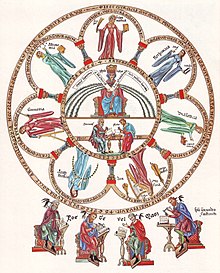
Back فنون متحررة Arabic Artes lliberales AST Liberal sənət təhsili Azerbaijani Ирекле ете сәнғәт Bashkir Сем вольных мастацтваў Byelorussian Сем вольных мастацтваў BE-X-OLD Arts liberals Catalan Sedm svobodných umění Czech Ирĕклĕ çичĕ ӳнер CV Y celfyddydau breiniol Welsh

Liberal arts education (from Latin liberalis 'free' and ars 'art or principled practice')[1] is a traditional academic course in Western higher education.[2] Liberal arts takes the term art in the sense of a learned skill rather than specifically the fine arts. Liberal arts education can refer to studies in a liberal arts degree course or to a university education more generally. Such a course of study contrasts with those that are principally vocational, professional, or technical, as well as religiously based courses.[3]
The term liberal arts for an educational curriculum dates back to classical antiquity in the West, but has changed its meaning considerably, mostly expanding it. The seven subjects in the ancient and medieval meaning came to be divided into the trivium of rhetoric, grammar, and logic, and the quadrivium of astronomy, arithmetic, geometry, and music. Since the late 1990s, major universities have gradually dropped the term liberal arts from their curriculum or created schools for liberal art disciplines to categorize programs outside of science and technology. Common rebrandings for liberal arts colleges and schools include: arts and social sciences, arts and sciences and humanities. The name changing at American institutions comes as the result of modern statistics suggesting a Liberal Arts degree offers graduates a considerably lower income when compared to science and technology graduates.[4][5][6] Despite the rebranding, liberal arts degrees from today's universities and colleges traditionally include the following disciplines: Anthropology, English, Literature, Fine arts, Foreign languages, Philosophy, Psychology, Sociology, Music, Journalism, Economics, Law, Communications, Architecture, Creative arts, Art, and History. Degrees in Liberal studies are often confused with those in a liberal arts discipline. Liberal studies refers to degrees with a broad curriculum, across multiple liberal arts disciplines or sciences and technologies.
- ^ "MA Liberal Arts | Course Overview". University of Winchester. Retrieved 6 February 2022.
- ^ "What is Liberal Arts? – Ancient, Medieval, Modern". Liberal Arts UK. Retrieved 4 June 2018.
- ^ "Liberal Arts".
- ^ "University works to revive liberal arts as a key part of the college experience". pbs.org. public broadcasting system. Retrieved 1 November 2024.
- ^ "Field of degree: Liberal arts". bls.gov/. Bureau of Labor and Statistics. Retrieved 1 November 2024.
- ^ "What does Liberal Arts Mean?".